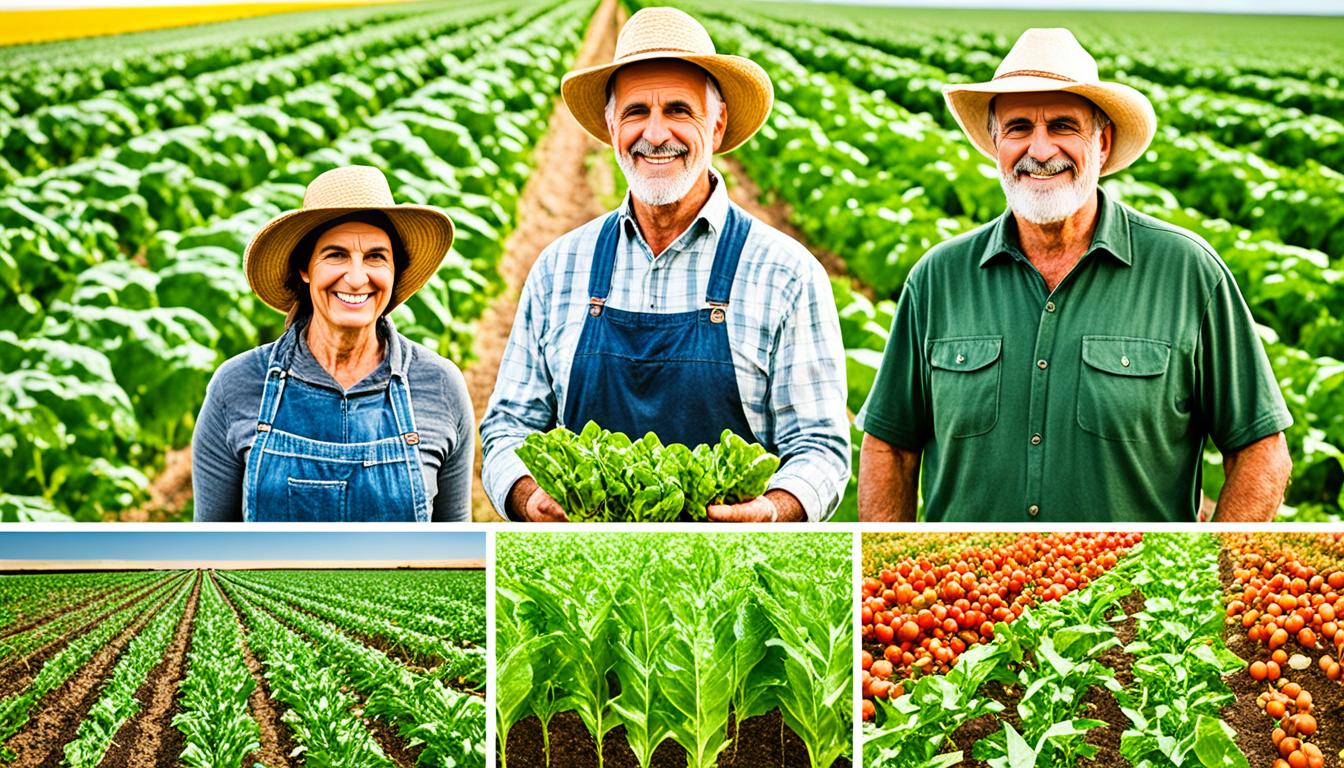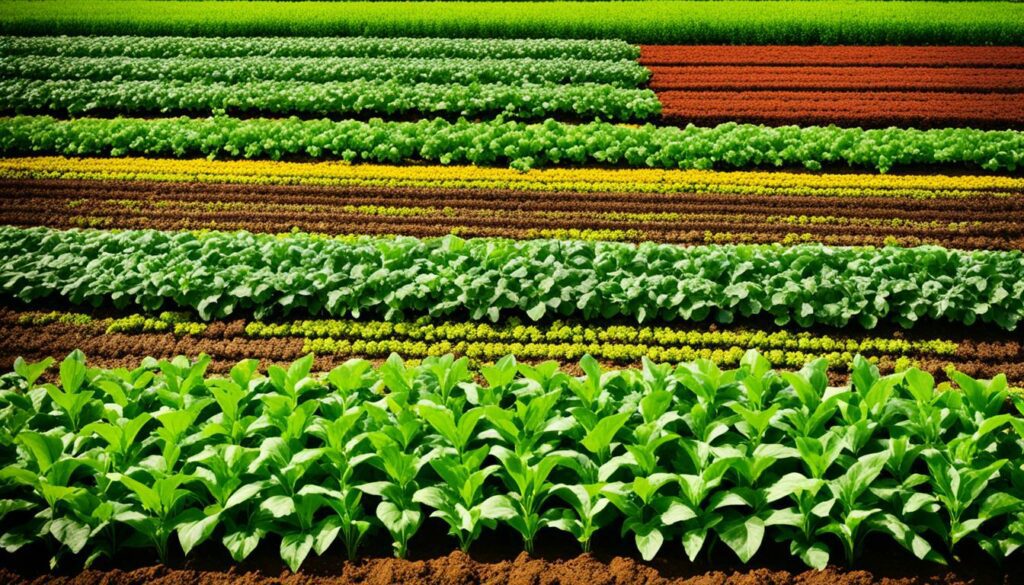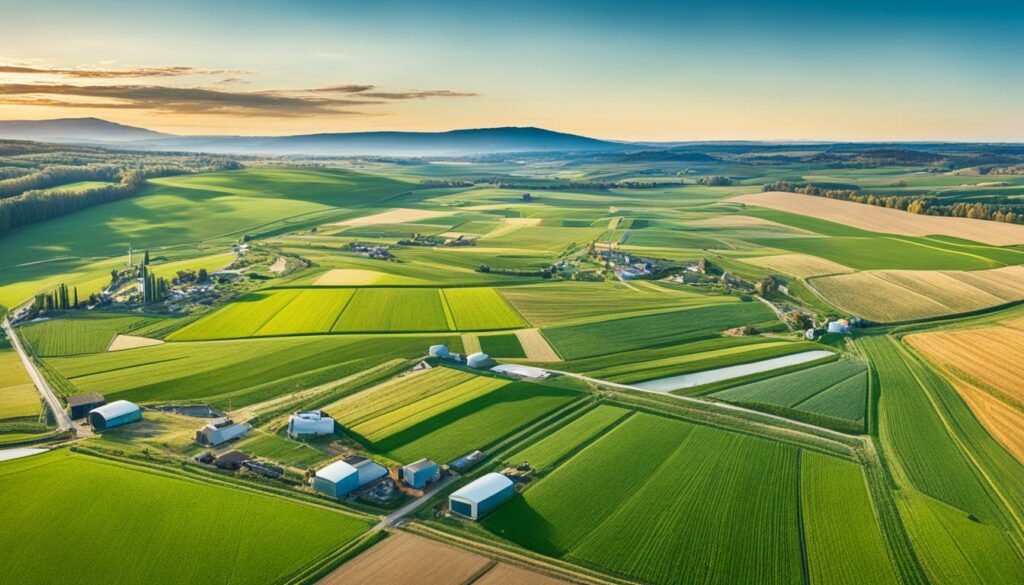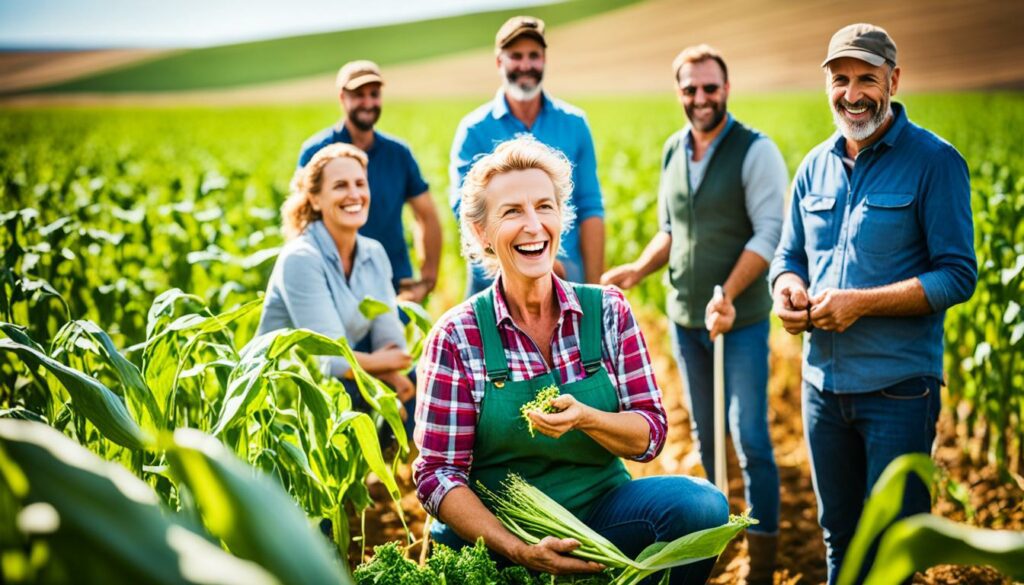Menu

Did you know a study looked at 30 EU case studies on teamwork? It found that what happens inside a group is more important than what’s outside it. This shows how coming together can make farming more sustainable. We’ll look at some great examples of how working together can improve farming for both people and the planet.
By looking at these real-life stories of teamwork in farming, you’ll learn a lot about sustainable agriculture’s future. Working together can help protect the environment, make farming better for everyone, and encourage new ideas.
Agricultural collaborations are key to improving farming. They help use resources better and find new ways to solve problems. These efforts bring together various aspects of farming, like social connections, looking after nature, and the benefits of working together. As a result, the whole farming community gains.
Working together in farming makes it easier to take care of the environment. Groups who focus on eco-friendly farming manage natural resources well. This helps the natural world around us, keeping it healthy for the future.
Studies in the EU show that green farming is more successful with groups working together. They share skills and knowledge, which brings them all benefits. This way, everyone learns and the environment wins.
Teamwork in farming strengthens ties in the community and helps farmers work together better. Studies show that what farmers do together is more important than outside factors. By joining forces, farmers enjoy sharing what they know, helping everyone learn more.
In Iran, experts highlighted the importance of good policies for these farming groups. With the right policies, farming practices can be better coordinated. This leads to more success for everyone involved, both socially and economically.
Working together boosts the economy of farming areas. It helps save money, improves the power to make good deals, and offers more funding options. These benefits were found to matter a lot in a study, almost as much as good policies.
Collaborative projects in farming make everything more efficient. Members can invest in new technology together, which cuts costs. They also sell their products directly, making more money. For example, in Réseau Semences Paysannes (RSP), farmers sell many kinds of crops directly. This shows that working together can be economically successful.
To sum up, farming collaborations help in many ways. They make farming more eco-friendly, strengthen communities, and help with the economy. By working as a team, farms can be better for the planet and for the people.
In agriculture, working together from different sectors has big benefits. These partnerships show how we can all work towards making things better. They show how joining forces can lead to success through shared projects. Here, we’ll look at two partnerships that really stand out.
In Nebraska, ADM and PepsiCo teamed up for a significant project. Called the Cover Cropping Project, it was a success. In its first year, they aimed to plant cover crops on 15,000 acres but did over 15,800 acres instead.
This three-year effort started in 2022. Practical Farmers of Iowa, Keurig Dr Pepper, and Farmers Business Network are also a part of it. It shows strong partnership can go a long way.

They use the Fieldprint Platform™ to track how well they’re doing. The good news is, they’re seeing better soil and water, and less greenhouse gas. It’s not just about the environment. They’re also helping farmers learn from each other. This way, they support each other and find new ways to be sustainable.
The Unilever-PepsiCo Soil Health Innovation Project is another great example. It focuses on improving soil health and sustainability. The key is helping farmers by giving both money and know-how to grow their practices. The project has done well, especially in starting cover cropping and new farming methods.
It isn’t just a good idea; it’s also working. With the right tools and solid support, they can really achieve sustainable farming. This project shows it’s all possible.
The success of these partnerships is clear. They bring real benefits. By mixing business goals with caring for the planet, they show us a better way. These examples show how together, we can make farming strong and green.
An in-depth study across the EU has looked at how local and regional groups work together on farming. It found key points that make these partnerships thrive. This is crucial in a sector where working together means a lot.
Looking at data from 30 projects showed the many sides of farming collaborations. Through this deep look, we found external, actor, and organisational management matters all play a part. It’s like having many gears working together to make a machine run smoothly.
This research showed us that certain external and internal factors are very important for success. Knowing this helps focus our efforts. We also learned that balancing social and economic goals can make collaborations even better. This is crucial for making shared efforts work well for everyone.
The EU study dug into what really drives success when people and groups work together on farming. It turns out, what’s inside a group is more important than what’s outside. Groups need to build their skills to face challenges together.
We also found many advantages to these partnerships. People get to know each other better, have more power to negotiate, share costs, and learn together. Plus, they can pool money for bigger projects and access more funding. These all help in creating smarter, more efficient solutions on a local level.
| Factor Type | Identified Factors |
|---|---|
| External | 2 Factors |
| Actor-Related | 5 Factors |
| Organisation and Management | 5 Factors |
Cover cropping plays a major role in making farms stronger against challenges. It does this by improving soil and helping the environment. To make this work, farmers need support, money, and help to get started and keep going.
Technical help is key for farmers to use cover cropping well. In 2022, the Farmers Business Network (FBN) joined in to offer more help. The Practical Farmers of Iowa (PFI) also let farmers learn from each other, sharing the best ways to do things.

Cover cropping needs both money and systems to support it. In Columbus, Nebraska, the goal for acres covered was exceeded by 15,000 thanks to PepsiCo and KDP’s teamwork. This great work shows how supporting regenerative agriculture can achieve big results.
Financial support also comes from Kellogg’s via the USDA’s Regional Conservation Partnership Program. This helps with the money and the advice farmers need to succeed. The Nature Conservancy is also helping farmers make these changes, adding to the project’s success.
By using Field to Market metrics and cover cropping, farmers see what they can do better. This shows that combining money and technical help can really drive positive change in farming.
| Farmer Support Mechanisms | Description |
|---|---|
| Technical Assistance | Farmers Business Network (FBN), Practical Farmers of Iowa (PFI) |
| Funding Programs | USDA’s Regional Conservation Partnership, Financial contributions from Kellogg’s |
| Metrics and Reporting Tools | Fieldprint Platform™, Land.db by Syngenta |
Farmer cooperatives are changing agriculture for the better. They help farmers join forces to tackle big challenges. This approach makes hard tasks easier by sharing the load.
In farming, having strong community ties is vital. In Wisconsin, many sustainable farmers wanted to start a business owned by farmers. This shows how working together can create stronger communities.
Across the EU, over 163 million people own farming cooperatives. This means about a third of its population is involved!
Farming cooperatives offer big economic benefits. They give farmers a better hold on the market and the chance to invest together. For example, in the EU, these groups have a big influence. They cover 50% in France to 83% in the Netherlands of the market.
Working together lets farmers try new, sustainable methods. And with more people wanting organic food, there are even more opportunities.
Farmers in cooperatives can bargain better with others. In Wisconsin, many buyers wanted local products, but cost was a concern. Yet, if the local network got better, over half of them would buy more local.
These results show farmers in cooperatives can make a real difference by negotiating smartly.
| Country | Agricultural Cooperative Market Share |
|---|---|
| France | 50% |
| Italy | 55% |
| Finland | 79% |
| Netherlands | 83% |
The world of sustainable farming has changed a lot with the rise of agribusiness joint ventures. These partnerships have brought big boosts to farming efforts. They’re making agriculture both more productive and better for the planet, pushing us towards more innovation.
In farming, different collaboration models are bringing great results. Studies show that success often hinges on how well people work together and adapt. It’s not just about what happens inside the group, but how they handle challenges from the outside too.
Take the Cedar Citrus project, for example. Half of it is owned by workers. It’s been making money every year since 2010. Another success story is the Grassland Development Trust, which helped people own land through a mix of grants and loans.
The Suurbraak Grain Farmers Cooperative is a shining example. It pools money from members and loans to grow. Its success supports the idea that flexibility is key to making these ventures work.
Joint ventures lead the way to new markets and better tech for farmers. This lessens the financial burden and sparks fresh ideas. For investors, these deals stand out too. They offer a chance at big payoffs in the ever-growing food industry, with less risk.
| Case Study | Key Features | Outcome |
|---|---|---|
| Cedar Citrus | 50% employee-owned, established in land redistribution program | Consistent profits since 2010 |
| Grassland Development Trust | Land purchased through grant and bank loan | 100% land ownership transferred to beneficiaries |
| Suurbraak Grain Farmers Cooperative | Initial funding from Committee, external loans | Success reliant on cooperative funds |
| Mondi | Resolved 17 land-claims since 2008 | Viable joint ventures through adaptable practices |
These partnerships are not just good for the people involved. They help keep farming sustainable and push for more ways to innovate.
Creating strong agricultural partnerships through peer support networks is crucial. These networks help farmers share knowledge and adopt new, sustainable methods.

A farming peer-to-peer learning project involved 38 farmers. They exceeded their cover crop planting goal. Key organisations like ADM, PepsiCo, and more played vital roles.
This project highlighted the need for structured support. It showed great early results in improving soil health and reducing emissions.
Forming strong agricultural partnerships requires ongoing teamwork. Using tools like Field to Market helps improve outcomes. It also tracks key environmental gains.
The MRCC’s success with 2,650 farmers in 2022 shows what partnerships can achieve. They aim to spread better farming on 30 million acres by 2030, reducing emissions by 7 million tons. Big support from HSBC shows a commitment to these efforts.
In summary, supporting farming networks helps drive positive changes. Working together, we can implement practices that are good for the planet and farmers.
Keeping track of environmental effects in farming is vital for sustainability. Advanced tools like the Fieldprint Platform app make monitoring key metrics easy. It helps check soil health and improves sustainability strategies.
The Field to Market’s Fieldprint Platform™ is top for watching farm effects on nature. It lets farmers and experts see the environmental costs of their work. It looks at energy used, gas emissions, water quality, and the living things on farms.
“The Fieldprint Platform™ allows us to benchmark our sustainability progress against national and regional averages, providing a clearer path towards reducing our environmental footprint,” said a representative from a leading agricultural cooperative.
| Indicator | Benefit | Measurement Method |
|---|---|---|
| Energy Use | Reduction in fuel and electricity consumption | Fieldprint Platform’s energy efficiency module |
| Greenhouse Gas Emissions | Decrease in CO2e emissions | Carbon footprint calculator within Fieldprint |
| Water Quality | Improved runoff management and irrigation | Water quality indicators |
| Biodiversity | Enhanced habitat for diverse species | Fieldprint biodiversity assessment |
Watching soil health is key to sustainable farming. Good soil systems help farmers keep soil rich and avoid erosion. This boosts crop growth and saves the environment.
Global projects show the power of caring for soil. In Ghana, a program made cocoa farms more productive. And in Ethiopia, a project improved 503 hectares of forests by stopping erosion.
Using tools like the Fieldprint Platform with good soil health plans is crucial for a better environment. These techs help farmers be greener and understand their ecosystems more.
Agricultural collaborations are changing rural areas in big ways. They’re making communities stronger in farming. These projects help make farming better and also improve how farming areas look.

Rural areas grow when communities are strong in farming. By working together, local people can make farming practices better. This, in turn, makes their lives better. An example is the French TI programme. It helps people in 149 places improve how they farm. It focuses on things like helping workers move around better and learn new skills.
This programme is great at joining different levels of government to help. It makes plans that fit each area’s needs well.
Building better farming facilities is also key. Money is not always the main problem. Sometimes, it’s hard to find people who know how to farm well. Also, finding the right land can be tough. To help with these, it’s important to invest in better ways to move products, places to store things, and where to process food.
For example, France is a top country for making things because of its good infrastructure. The TI programme focuses on making land better and using more eco-friendly ways. This shows how building up areas can make a big difference.
It’s clear that focusing on certain policies can help rural areas a lot. It’s about making sure farmers have what they need to do well. Plus, it helps everyone in the community have a better life.
Agriculture is moving forward thanks to teamwork. The push for new high-tech tools and creative techniques is growing stronger. Partnerships in the field have made farming more efficient lately.
Four new Agri-Tech Innovation Centres are changing the game. Places like the Agri-EPI Centre and Agrimetrics are bringing new tech to farms. They help improve how we grow food and keep it safe. Events like the one at Highland Hall show how these centres are modernising old ways of farming.
Partnerships between places like The James Hutton Institute and business leaders drive new farming methods. They share the latest farming techniques. This helps farmers get better over time. Projects like Migration Linkages and CiYuan are not only about farming but also about making things better for workers and the environment.
Firms that put money into Research, Development, and Innovation (RD&I) usually do well. Teagasc is a great example with its farming predictions up to 2035. It works with others like Dairy Concepts IRL to make farming greener and more profitable. Collaboration can make farming both sustainable and successful.
Sustainable farming cooperatives lead the way in making farming profitable and eco-friendly. They focus on working together, sharing tools, and taking actions as a group. This way, they succeed in their goals.

Economic strength in farming is hit by working together and using resources as one. A study of 30 projects in the EU found that good management and how the people involved act are key. For example, India produced a massive 303.34 million tonnes of goods in agriculture last year because of these cooperative efforts.
Some important data shows:
These cooperatives help distribute costs and gains fairly among their members. This helps them stay strong financially.
Being good to the environment is a key outcome of these farming groups. They use methods that are kind to the earth, like taking care of the soil, less use of chemicals, and promoting different types of living things. India is a good example because its farmers work together to use the land well and need fewer chemicals.
The success of these groups is linked to:
By acting as one, these cooperatives can both better the environment and make farming methods last a long time. They set an example of how combining efforts can improve farming.
To wrap up, these cooperative farming projects are very important for the economy and the environment. They show a good way forward for working together in farming.
Looking at how farmers’ lives change and how these models can grow wider shows us some powerful stories of success. After studying 30 projects in the EU, we’ve found key things that make these collaborations work. These factors include focusing on both social and money goals and the more important role of the people and the groups themselves over outside conditions.
Agricultural partnerships greatly help farmers, not just by sharing what they know but also by learning together. This kind of working together is key for keeping farms going strong, especially with more people to feed than ever before. By working in groups, farmers can get more money, have more stability, and can do bigger things together. This shows how teaming up really pays off for them.
This way of working isn’t just good for a few; it can really spread and help more if done right. It saves costs and makes using resources smarter. It’s clear these partnerships can grow and change with more needs or situations. Take Nigeria’s rice output, for instance, it grew from 7.8 million tons in 1960 to 25 million tons in 2016, showing the big impact of teaming up.
These partnerships also make nature stronger by linking habitats and making landscapes richer. Working together in agriculture really can bring major social, money, and environment gains. By joining hands in farming, we could start a new chapter of farming that’s good for everyone and the planet.
The Nebraska Cover Cropping Project by ADM-PepsiCo stands out. So does the Unilever-PepsiCo Soil Health Innovation Project. These cases show how partnerships boost sustainability and productivity in farming. They do this through new methods.
These partnerships improve how we use resources and the health of our land. They often focus on practices like cover cropping. This helps soil, plants, and animals thrive. It also lessens harm to the environment.
Working together makes farming communities stronger. It helps farmers learn from each other and support one another. This improves their relationships. It also lifts up the whole community.
Joining forces saves money, opens up new funds, and allows sharing of knowledge. This makes farming more cost-effective. It lets farmers try new, better ways. It also makes them stronger in the market.
A big look at EU studies found that good management and clear goals matter a lot. It’s about balancing different needs well. This leads to success in helping nature, people, and making money all at once.
Cover cropping helps the soil stay healthy and the farm more sustainable. But, it needs support to start and keep going. Things like advice and money are key to making it work.
Farmer groups build team spirit, help farmers invest together, and give them more power together. This is good for the earth and for making a living. They help farmers help each other, reaching economic and green goals just the same.
There are many smart partnerships in farming that have done well. They’ve brought new ways of working together. These have uplifted farming, making it more innovative and effective.
Learning from each other and building networks is vital in farming. It keeps farmers sharp and helps spread good ideas. By working together, they get better, faster.
The Fieldprint Platform™ tracks how well farming helps the environment. It’s good for the soil, for plants and animals, and for cutting down on harmful gases.
Working together makes rural areas stronger. It builds new things and makes old ones better. This helps the countryside thrive, growing in a way that’s good for the long term.
Partnerships make it easier to get and use new knowledge and tools in farming. This boosts how well and how new farming works. Together, farmers can do more, and do it better.
Co-ops help farmers make money in ways that are also good for nature. This is about winning on both fronts. It shows a good way forward for farming, in all kinds of places.